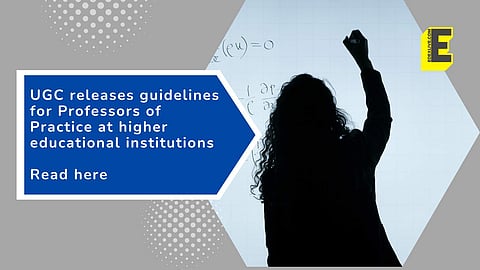

The UGC has said that the move aims to strengthen industry-academia collaboration and is in accordance with the provisions of the National Education Policy (NEP). "For skilling of youth at the optimum level, learners are required to think like employers and employers are to think like learners," said the UGC.
Professors of Practice are not only supposed to bring in expertise from their respective fields to provide training and skilling to the students but also to develop curricula and courses to support this form of learning.
With regards to the faculty of the colleges, the Professors of Practice will be required to deliver special lectures, workshops, seminars and training programmes in collaboration with the faculty. Additionally, they are also expected to partake in joint research projects and consultancy services with the faculty.
What the guidelines say
The UGC Guidelines also lay down the regulations for hiring a Professor of Practice. For starters, this position is exclusive of the regular faculty's recruitment and sanctioned post. Professors of Practice are supposed to be hired beyond those posts. At any given time, the number of Professors of Practice at an institution should not extend beyond 10% of the sanctioned faculty posts in the institution. Teaching professionals, whether active or retired, are not to be considered for the post of Professor of Practice.
Three modules for hiring
There are three modules for hiring a Professor of Practice, according to the UGC Guidelines. Professors of Practice can be funded by the industry, which refers to the organisation the individual is working with professionally. Higher Educational Institutions can also hire Professors of Practice and fund them from their own resources. In this scenario, the UGC guidelines state that the professor must be paid a consolidated amount, mutually agreed upon by the institution and the professional. Then there are Professors of Practice who choose to teach on an honourary basis, and in this case, institutions can decide the honorarium amount to be paid from their own resources, state the guidelines.
Nomination, selection, extension
It is the Vice-Chancellors or the Directors of the institution that will invite nominations from industry experts to become Professors of Practice. Then, once nominations are received, a selection committee will deliberate on these nominations. This selection committee will comprise two professors from the institution and one reputed external member. Then the statutory bodies of the institutions will finalise the appointments.
The maximum that institutions can hire a Professor of Practice at a stretch is three years. This term is extendable by only up to one year under "exceptional circumstances", the UGC states. However, the initial period of appointment is one year and that will be extended based on an assessment by the institution.
The UGC has also sent letters to members of the industry and businesses to participate in the initiative. These letters, shared with EdexLive, were sent to the Federation of Indian Chambers of Commerce and Industry (FICCI), National Association of Software and Service Companies (NASCOM), Confederation of Indian Industry (CII) and Associated Chambers of Commerce and Industry of India (ASSOCHAM).
A letter was also addressed to universities and colleges, stating, "Realising that the HEls need people with skills and expertise acquired in non-academic careers, in teaching and research, the UGC has taken a new initiative of engaging Professor of Practice in HEls."
